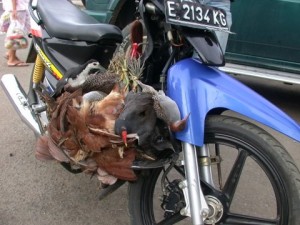 Hosts: Vincent Racaniello, Rich Condit, Dickson Despommier, Alan Dove, and Kathy Spindler
Hosts: Vincent Racaniello, Rich Condit, Dickson Despommier, Alan Dove, and Kathy Spindler
The complete TWiV team reviews the controversial publication of the HeLa cell genome, a missing vial of Guanarito virus in a BSL-4 facility, and human infections with avian influenza H7N9 virus.
Click arrow to play
Download TWiV 227 (69 MB .mp3, 95 min)
Subscribe (free): iTunes, RSS, email
Links for this episode:
- Containment plan for poliovirus (pdf, WHO)
- Post-eradication of polio
- Ocular tropism of respiratory viruses (MMBR)
- Rally for medical research
- HeLa genome sequence withdrawn (ScienceInsider)
- Immortal life sequel (Rebecca Skloot)
- HeLa genome sequence published, withdrawn (virology blog)
- Vial of Guanarito virus missing (ABC news)
- Human H7N9 infections (ProMedMail)
- WHO H7N9 updates
- China escalates H7N9 response (NY Times)
- Brian Kimble on H7N9
- Compatibility of H9N2 and H1N1 genes (PNAS)
- Letters read on TWiV 227
Weekly Science Picks
Kathy – NIAID YouTube videos
Alan – Lego insects
Rich – How to see the world in a grain of sand
Vincent – Vaccines, viruses, and the anti-vax movement
Dickson – Edinburgh Science Festival
Listener Pick of the Week
Stephen – Nature iOS app
Mehul – Voices for vaccines
Send your virology questions and comments (email or mp3 file) to [email protected]


I found the discussion on privacy issues around publication and retraction of sequences of the HeLa cells very interesting. And it made me wonder…
I understand these immortal cancer-derived cells are different from normal cells, so they may not perfectly replicate what would happen inside normal human cells, but even discounting that, it would not be a useful tool to do science unless these cells from the same origin spread around labs all over the world are still “the same”. If HeLa cells at Vincent’s lab and those at Rich’s lab have now diverged too much and react differently to the same virus, replication studies would be very hard to do.
Another thing I wonder is if the HeLa cells kept at labs today are the same as those used 10 or 20 years ago, or if they somehow mutated and behave even more differently from normal human cells.
How do scientists make sure HeLa cells their lab keep are still the same as everybody else’s, have not changed over time, and still a useful model? Sequencing from time to time and comparing the result between labs (and with the record of previous sequencing) is one way a layperson like me can think of off-hand, but that sounds still a bit too expensive and cumbersome.
Thank you always for interesting podcast. Many times I find the discussion full of three-letter-acronyms way over my level of understanding, but the happiness in voices of real scientists having fun talking about sciences they love alone is contagious and urges me to listen to new episode every Sunday.
40:00 H7N9, poultry markets in China etc.
43:30 HP vs. LP
47:00 reassortant
gsgs – I’ll probably reply later in more detail
almost all flu-A are reassortants, better ask when did the last one
happen ?
mallards frequently swap HA(4) and NA(6)
48:30 W-shape for H5N1
49:15 serine at 61 as 1918 (what segment ?)
50:00 alpha 2,6
50:00 correction W-shape for H1N1(2009)
51:00 infecting humans since thousands of years
52:00 speculates about much undetected infection
in humans by all 16*9 types “millenia”
(common ancester of HAs and NAs ~400years ago)
>rare exposure to mallards, poultry swine exploded in
> recent decades
55:00 pigs in river
56:00 maybe a weather event
Brian Kimble’s blog
57:00 gsgs – happened in chickens cause there are many similar H9N2
chickens at genbank
( segments 1,2,3,5,7,8) even from 2012,2013
57:30
58:00 predictions: all say “no”, I agree, but Vincent should have asked for
subjective
probabilities instead, not just is it danger is reassortment
1:02:00 Kimble paper, 2011 about H9N2+H1N1 in ferrets
1:05:00 emails
1:21 insects from lego-pieces
1:25 debate (email) professional fraudsters
Alan Dove against antivax debate
1:31 google flu
was on TWIV
profvrr mentioned google+ … is that where the scientists meet ?
I rarely find them talking online.
OK, so I created a blog there and put some info about H7N9 on it
http://gsgs2.blogspot.de
I’m planning to improve,complete this later and add new info when
new sequences are published (hopefully in genbank)